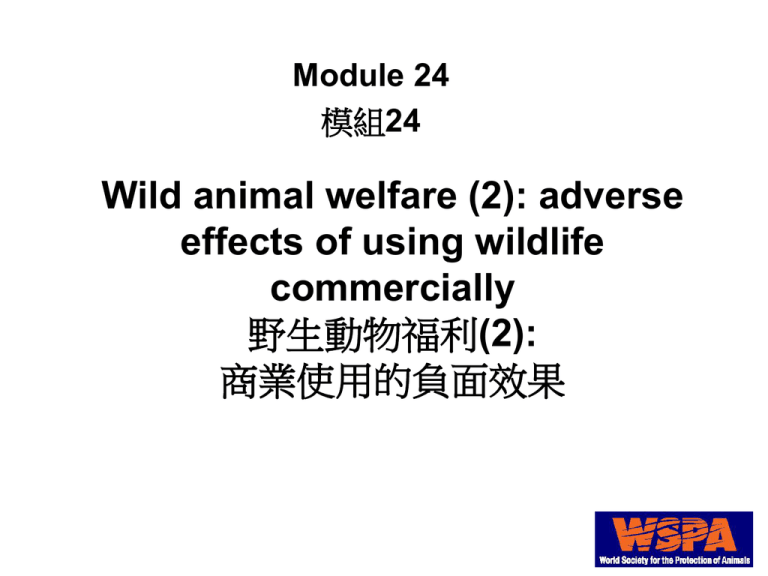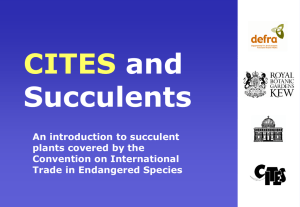24_Wildlives(II) 野生動物
advertisement

Module 24 模組24 Wild animal welfare (2): adverse effects of using wildlife commercially 野生動物福利(2): 商業使用的負面效果 This module will enable you to 本模組將使您能夠 • Learn about the commercial exploitation of certain wild animal species學習並了解某些野 生動物物種的商業剝削 • Learn about the international trade in these species and their products學習有關這些野生 動物物種之國際買賣與其產品 • Understand the welfare and conservation implications of these industries了解這些企業 對動物福利與保育的影響 • Identify humane, alternative products available認識既有的相關人道替代品 Introduction 前言 • Several factors drive the commercial exploitation of wild animal species有很多因子導致野生動物之商業剝 削 • Different types of exploitation have various effects on the welfare of animals不同之剝削對動物福利有不同之 影響 • Animals may be wild caught or captive bred動物可能 來自於野外捕捉動物或籠飼生產 • They may be traded alive or dead (whole, in parts or in processed products)被活或死(整體,部份或加工品) 的出售 • There are both animal welfare and conservation implications同時有動物福利與保育之問題 International regulations 國際規範 • Convention on International Trade in Endangered Species of wild fauna and flora (CITES) 「華盛頓公約---瀕臨絕種野生動植 物國際貿易公約」,公約的目的在藉由管制國際貿易來保護野生 動植物物種,以免因大量之貿易使其從地球上消失。 • Animal Transportation Association (AATA) 「動物運輸協會」 舊 名是: The Animal Air Transportation Association • International Air Transport Association (IATA) 「國際航空運輸 協會」,於一九四五年由各飛航國際航線之航空公司聯合組成, 該組織與國際民航組織(ICAO International Civil Aviation Organization)互動密切,為一個半官方之國際機構,IATA總部設 於加拿大蒙特婁,另在瑞士日內瓦設有辦事處。 CITES – background 「華盛頓公約---瀕臨絕種野生動植物國 際貿易公約」背景 • Convention on International Trade in Endangered Species of wild fauna and flora (CITES)目的在藉由管 制國際貿易來保護野生動植物物種,以免因大量之貿易 使其從地球上消失。(CITES) • International agreement to control the international trade of endangered species of animals and plants管 理瀕臨絕種動植物國際貿易之國際協定 • Originally 25 member countries in 1973, there are now 169 countries party to the Convention最初是25個 會員國(1973),目前有169個國家會員 CITES – overview 華盛頓公約--概述 • Species are categorised according to the level of threat imposed on them by international trade按照 國際貿易對其威脅,將物種分類 • A species CITES status affects the ability to trade in that species物種在公約內之地位影響該物種之貿易 能力 – CITES Appendix I affords the greatest protection (公約附錄一提供最高程度之保護物種) • Strength of CITES depends on the introduction and enforcement of laws by the member Parties (countries)公約效力靠締約國之立法與執法。 CITES – structure 華盛頓公約--組織架構 • Original Convention text創會之組織章程 • Resolution and Decision documents按照會議之 決議執行 • CITES meetings: Conference of the Parties, Standing Committee, Animals Committee, Plants Committee會議: 締約國大會、常務委員會、動物 委員會、植物委員會 • Species Appendices I, II & III根據貿易壓力調整 物種附錄別 CITES – decision making 華盛頓公約--決策過程 • CITES Secretariat – coordination秘書處---協調 • CITES Committees: Standing, Animals, Plants – voting power常務,動物,植物三個委員會---有投票 權 • Parties to CITES – voting power會員國---有投票 權 • Non-Governmental Organisations (NGOs) – present findings, lobby Parties非政府組織---蒐證, 遊說 CITES – conservation and welfare 華盛頓公約--保育與動物福利 • CITES is primarily concerned about the effects of trade on species population levels – conservation公約主要是關心貿易對物種族群之 影響(保育) • BUT animal welfare is covered in the original text of the Convention (Articles III, IV and V) and in the ranching and captive breeding resolutions 但是動物福利也包含在大會原初之組織章程(第III, IV, V條) ,在有關牧場與籠飼動物繁殖之決議方 面。 AATA 動物運輸協會 • Animal Transportation Association動物運輸協會 • Established in 1976 in response to the concerns of industry leaders, government officials, and humane association representatives在1976年因企業領袖、政 府官員、與人道組織代表之關懷而成立 • AATA disseminates information and encourages collaboration to ensure safe and humane transport of animals動物運輸協會散播資訊鼓勵合作以確保動物運 輸之人道與安全 • AATA members include airlines, truckers and shipping firms, government agencies協會會員有航空 業,貨運業,海運業,與政府機關 IATA 國際航空運輸協會 • International Air Transport Association國際航空運輸 協會 • Formed in 1919, IATA aims to ensure that people, cargo and mail are easily transported around the globe最初建立於1919年,國際航空運輸協會致力於確 保人員、貨物、郵件順暢 • IATA Live Animals Regulations are the worldwide standards for transporting live animals by commercial airlines國際航空運輸協會活體動物的商業運輸規則商 用航空公司活體動物運輸之世界標準 – Provide specific guidelines on the container size required for transporting animals提供運輸動物籠舍 規格需求之特殊指導方針 Welfare issues affecting free-living wild animals影響野生動物之福利議題 • • WSPA survey 2006 WSPA的調查(2006) – Welfare issues affecting free-living wild animals in Sub-Saharan Africa & Latin America 非洲南撒哈拉 與拉丁美洲的野生動物福利議題 – Identified 3 categories 區分為3類 1. Trapping, hunting & fishing誘捕、狩獵與漁獵 2. Trade in live wild animals or their parts活體野生動物 或其製品的交易 3. Human encroachment (see Module 23)人類的侵入 (見模組23) Applicable to all species throughout the world可應用於 全世界所有物種 Trapping, hunting & fishing 誘捕、狩獵與漁獵 • Trapping:誘捕: – “Using traps to capture & kill target & non-target animals by humans for food, commercial gain or pleasure”人類為了食物、商業利益及樂趣,使用陷 阱去捕捉、殺害動物(無論是否為獵物) • Hunting:狩獵: – “the stalking, chasing & killing using a variety of weapons (rifles, spears etc.) and/or dogs to chase, bring down and dispatch animals” 使用武器(萊福 槍、矛)來跟蹤、追捕與殺害動物,或使用狗來追捕、 壓制、殺死動物。 Trapping, hunting & fishing 誘捕、狩獵與漁獵 • Fishing:漁獵: – “the specific hunting & killing of fish, crustaceans, cephalopods, amphibians & some invertebrates by hooking, trapping or gathering of these animals”專 指使用釣鉤、陷阱、網撈來捕殺魚類、甲殼類、頭 足類、兩棲類及某些無脊椎動物 Trapping, hunting & fishing 誘捕、狩獵與漁獵 Almost all wild animals affected including: 幾乎所有的野生動物都會受到影響,包括: – ‘Target’ animals e.g.獵物,如: • Antelope hunted by indigenous tribes土 著部落獵捕羚羊 • Big-game fishing--for trophy釣魚大賽— 獎品 – ‘Non-target’ animals (不小心捕獲的)非獵物 • Large African mammals, e.g. gorilla, bush dog or buffalo caught in snares誘 餌捕捉到大型非洲哺乳類,如:大猩猩、 非洲野犬、野牛 • Cetaceans, e.g. dolphins caught in fishing nets鯨目類,如:漁網捕撈到海豚 Reasons for trapping, hunting & fishing 誘捕、狩獵與漁獵之理由 • Wildlife used for food & other products食物與其他物資需 求 – Subsistence生計考量 – Commercial sale商業販賣 • Wildlife conflict with local communities野生動物與當地社 區之衝突 – Competition for food, risk to livestock & crops etc爭奪 食物資源,對家畜或農作物造成風險 – Population control, e.g. elephant culls數量控制,如:選 擇性地撲殺象群 • Recreation & sport e.g. trophies (bear, shark, &c) 休閒與運動,如:戰利品(熊、鯊魚) Bushmeat野肉 Effects of trapping, hunting & fishing on animal welfare 誘捕、狩獵、漁獵對動物福利的影響 • Whilst trapped 誘捕時 – Attempts to escape lead to injuries, disease & painful death試圖逃脫,因而造成受傷、病痛與痛 苦死亡 – Fear & frustration due to separation from their group 離群索居的恐懼與挫折 • Whilst being hunted 獵捕時 – Injuries incurred while trying to escape逃脫造成受 傷 – Fear due to presence of predator (hunter, dogs etc.) 掠食者的出現造成恐懼(獵犬等) Effects of trapping, hunting & fishing on animal welfare 誘捕、狩獵、漁獵對動物福利的影響 • Whilst being killed殺害時 –Inhumane & slow methods lead to pain & fear before death 不人道及緩慢的過程導致 死亡前的疼痛與恐懼 • While fish are caught on a hook 當魚被鉤子釣 起時 –Fear and distress because unable to escape 無法脫逃造成恐懼與緊迫 –Pain 疼痛 Trade in live wild animals 活體野生動物的商業貿易 • Practices involved in the capture, transport, housing & sale of wild animals to supply內容包括:捕捉、 運輸、飼育與販賣野生動物 ,藉 此提供下列產業的貨源 – Pet trade 寵物貿易 – Biomedical research 生物醫學 研究 – “Canned” hunts 打獵農場 – Zoos 動物園 • Affects wide variety of mammals, birds, reptiles, amphibians & fish 影響範圍涵蓋:哺乳類、鳥類、爬 蟲類、兩棲類跟魚類 Trade in live wild animals 活體野生動物的商業貿易 • Two broad categories: 廣泛分成兩類: – Local trade, e.g. caught & kept by local community (exotic pets)當地貿易,如:由 當地社區捕捉與飼養(外來種寵物) – National & international trade, e.g. caught, transported & sold nationally or internationally 國內與國際貿易,如:捕捉、 運輸及販賣動物到國內其他地方或國外 Causes of trade in live wild animals 活體野生動物商業貿易的成因 • Demand需求 – Pet market, e.g. parrots寵物市場, 如:鸚鵡 – Zoological collections, e.g. cetaceans 動物園的展示,如:鯨目 類 – Biomedical research, e.g. primates, wild birds etc.生物醫學 研究,如:靈長類、野生鳥類等 – Canned hunts, e.g. lions, cheetah, leopard etc. 打獵農場,如:獅子、 印度豹、美洲豹 • Supply供給 – Poverty, but high biodiversity貧窮, 但高生物多樣性 Effect of trade in live wild animals on the animals 活體野生動物商業貿易的效應 • Dependent on the stage in the trade process取決於貿易過程的各個階段 – Capture 捕捉 – Transport conditions 運輸狀況 – Captive housing conditions 飼養狀況 Trade in live wild animals: Capture and transport 活體野生動物的商業貿易: 捕捉與運輸 Trade in live wild animals: Ownership 活體野生動物的商業貿易: 飼主 • Following sale 把動物買回家以 後 – Lack of knowledge of animals’ need不了解動物的 需求 – Neglect or abandonment once novelty has worn off當 新奇感不再,就無視或棄養 – Animal not free to express natural behaviour動物無法 展現自然行為 Trade in live wild animals: Exotic pets 活體動物之交易:外來寵物貿易 Trade in live wild animals: Exotic pets 活體動物之交易:外來寵物貿易 • In shops 店內 – Lack of knowledge 缺乏知識 – Spread of diseases and parasites散播疾病 與寄生蟲 – Overcrowded stressful situations 密集飼養 的緊迫情形 Trade in live wild animals: Spread of disease 活體動物之交易: 散播疾病 • Monkeypox 猴痘 – In US in 2003 美國,2003年 – From Ghana 源自迦納 – Affected prairie dogs & human beings草原土 撥鼠與人類會受感染 (Southern Cooperative Wildife Disease Study 2003 ) Trade in parts of animals: Turtle shells 摘取動物身上某部分之交易:龜殼 Trade in parts of animals: Turtle shells 摘取動物身上某部分之交易:龜殼 Potential solutions: General 可能的解決辦法: 通論 • Promote education & awareness 提倡教育 與公眾意識 • Promote community-based, sustainable management of wildlife 提倡社區制、永續 發展的野生動物管理 – Feasibility? e.g. whaling 可行性? 如:捕鯨 • Increase legislation & enforcement 強化立 法與執法 • Promote alternative livelihoods 提倡多元的 維生方法 Potential solutions to trapping / hunting / fishing 誘捕、狩獵、漁獵的可能解決辦法 • Permanent removal of traps斬 草除根地移除陷阱 • Use of appropriate fishing nets 使用合宜的漁網 • Anti-poaching/trapping units反 盜獵/誘捕小組 • Non-wildlife related projects that benefit local people “跟野 生動物說NO”的相關計畫有助 當地居民 • Provision of alternative & ‘safe’ protein source提供其它安全的 蛋白質來源 • Increased funding for wildlife programmes增加保育野生動物 計畫的捐款 Potential solutions to the trade in wild animals 野生動物商業貿易的可能解決辦法 • Target end-market終結野生動物市場 – Educate sellers, consumers and public教育寵物業者、顧客與大眾 • Sustainable breeding of wild animals永續培育野生動物 • Sustainable, humane trade in wild animals永續經營野生動 物的商業貿易 • Further research進階研究 – Accurate & objective information is needed 要求準確 且客觀的資訊 Examples of wildlife ‘farming’ 野生動物的飼養案例 • Bear farming熊的農場化飼養 • Civet farming麝香貓的農場化飼養 • Fur trade and fur farming皮草貿易與毛皮獸農 場化飼養 Bear farming 熊的農場化飼養 • Bear gall bladders and bile are used in traditional Chinese medicine熊膽與熊膽汁用在中醫 • Started in China in the early 1980s as a government initiative to conserve wild bear populations1980 年代初期,為了保育,中國政府開 始進行熊的農場化飼養 • Concerns about animal welfare and conservation associated with the industry熊的農場化飼養問題涉及動 物福利與生態保育 • Bears on farms in Korea and Vietnam除中國外韓國越南都有熊農 場化生產 Bear farming – concerns 熊的農場化飼養--關切 • • • • Confined barren housing熊關在單調的籠舍內 Behavioural abnormalities熊行為異常 Poor reproductive success熊的生殖力很差 Early weaning and maternal separation提早斷 奶,與母親分離 • Inadequate veterinary support獸醫照顧不合宜 • Bears suffering from a variety of health problems熊因為各式各樣的 健康問題而受苦 • Captive populations supplemented with wild caught bears由野外捕捉 的熊補充籠舍內數量不足的生產族群 Bear farming熊的農場化飼養 Bear farming熊的農場化飼養 • China produces huge quantities of bear bile – over 7000 kg per year中國大量生產熊膽汁每年7,000公斤 • Only 4000 kg are used – the rest is stockpiled or illegally exported僅使用4,000公斤,剩餘的貯存或非法 外銷 • Bear bile is now used in many non-traditional products such as wines and tonics目前許多非傳統產 品之熊膽汁使用在製酒或滋補等用途 • Bear bile products are being illegally exported to many countries around the world in contravention to CITES熊膽汁產品被非法外銷到世界許多國家, 違反 CITES規章 Bear bile products熊膽汁產品 Bear farming and CITES 熊的農場化與華盛頓公約 • The Asiatic black bear is listed on Appendix I of CITES CITES 亞洲黑熊已列在華盛頓公約之附錄一內 • Resolution Conf. 10.8 – Conservation of and trade in bears在10.8之決議案指出熊屬於保育與貿易之列 • Resolution Conf. 12.10 – Registration of facilities breeding Appendix I species for commercial purposes附錄壹的動物禁止任何形式之貿易,本決議 同意在遵奉人道規定下仍可進行貿易,但抽取膽汁絕對 不符。 • Resolution Conf. 10.19 – Traditional medicines本決 議特別要求中醫要盡快找到取代之醫療方式。 Alternatives to bear bile 熊膽汁取代品 • Bear farming should end on the grounds of熊農場應該停止,基於: – extreme animal cruelty極度殘忍 – the negative effects on wild bear conservation破壞野熊保育 – the existence of suitable herbal forms of Traditional Chinese Medicine and of synthetic alternatives to bear bile既有之適 當中醫草藥與熊膽汁之合成之取代品 Alternatives to bear bile 熊膽汁取代品 • Consumer demand for bear bile products needs to be stopped 熊膽產品之消費需要停止 • The alternatives to bear bile need to be actively promoted相 關之取代品需要積極推動 • This work can be initiated by NGOs working with national governments這件工作需要由 NGO與政府合作 • Use of bear test kit now piloted by customs in Australia, Canada and other countries澳 大利亞、加拿大等國的海關使用 探測器來偵查熊膽製品 Civet farming 麝香貓農場 Civet farming 麝香貓農場 Fur trade: General overview皮草:一般情況 • Fur is used because of 使用皮草的原因: – Economic necessity經濟之必然性 – Financial gain--the high fashion industry經濟獲 益—時尚產業 • Use of fur for fashion is completely non-essential時尚 產業的使用完全不必要 – Many alternative and fake fur products available有 許多替代品,與仿冒品 • Severe animal welfare and conservation implications associated with both wild-caught and farmed fur animals有嚴重違反動物福利與保育情形,無論是野外 捕捉或農場飼養 Fur trade: Wild-caught animals 皮草貿易:野外捕捉 Fur figures 皮草貿易的數據 How many dead animals does it take to make a fur coat?生產一件外套需要多少隻動物? 65 mink水貂 20-30 domestic cats家貓 40-50 martens貂 16-20 beavers海狸 100-400 squirrels松鼠 12-18 ocelots豹貓 20-30 wallabies沙袋鼠 8-12 lynx山貓 60-80 sables黑貂 130-200 chinchillas栗鼠 10-12 badgers貛 10-24 foxes狐狸 10-16 otters水獺 60-70 skunks臭鼬 20-30 raccoons浣熊 3-5 wolves狼 Fur trade: Farmed species 皮草貿易:農場物種 Conclusions總結 • Commercial exploitation of wild animals has led to animal suffering, and to negative effects on wild populations worldwide野生動物的商業剝削讓全世界的動 物受苦並傷害族群 • Animals trapped, hunted or otherwise taken from the wild suffer and die during capture, transport, in shops or at markets, and in captivity誘捕、獵捕或用其他方式捕捉、 運輸、販售過程中,都可能使動物受苦或死亡 • Commercial exploitation of wild animals or their parts needs to be strictly controlled商業剝削需要嚴格控制 Conclusions總結 • Additional animal welfare regulations are needed to prevent wild animal suffering需要 進一步引進動物福利規範以防止動物受苦 • If the animal suffering cannot be alleviated, the commercial exploitation should cease 如 果動物無法避免受苦,應終止商業剝削 • Alternative, non-invasive forms of commercialisation, such as eco-tourism, should be investigated and actively promoted 取代性, 非侵入性之商業形式,如生態旅遊業 等應予思考 Further Reading • Animal Transportation Association (AATA): www.aataanimaltransport.org/ • The Bear Bile Business , WSPA 2002 • Bushmeat: Africa’s conservation crisis, WSPA 2000. • Civet Farming: An Ethiopian investigation, WSPA 1999. • Convention on International Trade in Endangered Species of wild fauna and flora (CITES): www.cites.org/ • Fashion Victims: An inquiry into the welfare of animals on fur farms, WSPA 1998.. • The Fur Inquiry: What you should know about the trapping, rearing and killing of fur animals, WSPA 1995. • The Illegal Trade in Hawksbill Turtles: Case studies from Indonesia and Japan, WSPA 2003. • International Air Transport Association (IATA): www.iata.org/ Further Reading • Southern Cooperative Wildife Disease Study 2003. Monkeypox introduced with exotic pets. SCWDS Briefs 19:2 • Turtle Alert: How the world’s biggest industry can help save one of the world’s oldest species, WSPA 1997.





